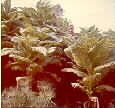

My Tobacco Project 1962 by Jess Scott
Return to Stith Valley, Return to
Scott Hill Farm
click photos to enlarge
Uncle Harold furnished the land and fertilizer for half the returns. Mama said that she wanted to have a fourth interest in the crop. That way daddy would have to do half the labor. This left me furnishing half the labor and receiving one fourth the returns.
At the first of April the plant bed had to be made. We made one bed for Daddy's crop and the one I had an interest in together. We chose a spot of rich, well-drained soil nine feet by one hundred feet, fertilized it , and worked it to plant. When the soil was worked well, we built a temporary fence around it for safety. We used meththyl bromide to sterilize the ground. Before the poison could be released, we scattered small bales of straw along the length of the bed in the middle. We put a heavy sheet of clear plastic on top of the straw bales, making it air tight by placing dirt along the edge of the plastic. The methyl bromide gas was then released under the plastic. After three days the ground was sterile. The only trouble that we had at all was with white clover and lespedeza whose seeds were not killed by the methyl bromide. Two days after the plastic cover was removed the ground was ready to rake and plant. April was a dry month and we had to water the bed all during the month. Around the middle of May we began to get worried because the plants weren't doing very well. We nitrated the bed and by the last of May there were more than enough plants to set Daddy's tobacco. A week later the bed furnished enough plants for the crop at Uncle Harold's farm. Many plants were left over above the amount needed for our crops.
At the first of May, Uncle Harold turned under the cover crop and put almost a ton of fertilizer on the tobacco ground. I helped Daddy set his tobacco at the last of May. At the first of June, while I was at 4-H camp, Uncle Harold worked the ground again and Daddy set the plants, spraying them for worms immediately afterward.
June the eighteenth I plowed the tobacco while Daddy sprayed it. We did this again on the first of July.
We topped the tobacco August the fifteenth and the next day sprayed it with M-H-30, a growth inhibitor which keeps the suckers down, and malathion. The M-H-30 slowed the growth of the suckers down a lot, but I had to sucker the tobacco before cutting.
We didn't prime all the tobacco. We primed three mornings till the dew went off, getting the dried and yellowed leaves. The difficulty was that that we tied too many leaves together and the base of the stems rotted before the leaves cured. It was difficult to pull the rotten parts off the stem from the leaves and put them into hands.
The weather was very dry at the last of the summer, and we kept putting off cutting the tobacco, hoping for a rain. Finally we cut half the crop. Then came the rain, and did it rain. It was not possible to cut tobacco from the last of August till the first of October. I guess we lost two hundred pounds by not cutting it all before the rain.
I was in school when the stripping was done, and I had to hire my part stripped. I did help strip some, though. It was late in the season when the tobacco stripping was completed and wasn't till January the fifteenth that it sold. There were sixteen hundred ninety two pounds on the seventy one hundredths acre, averaging twenty-three hundred eighty three pounds if we had an acre. It brought eight hundred sixty three dollars and thirty four cents at an average of forty seven and six tenths cents per pound, one fourth of which was mine.
hand of tobacco - To prepare tobacco for market, the leaves are pulled from the stalks. A handfull of leaves held from the stem end is wrapped with another leaf starting with the outside end of the leaf. The stem of that leaf is then inserted into the bundle so it will not unwrap. This tied bundle of leaves is called a hand.